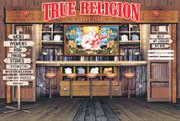Online Retailers Face Their Toughest Competition: Their Own Vendors
When Don Daszkowski scouted the Internet for potential competition to his fashion e-commerce Web site, Daszign.com, it was his search engine that pinpointed the toughest competitor he had encountered in his more than three years doing business. It wasn’t a rival e-commerce site. The fierce competitor was one of Daszign.com’s top vendors, manufacturer True Religion.
“It’s our No. 1 selling jean,” Daszkowski said. “When I looked at their site, I thought, there are a lot of counterfeit jeans out there. If you’re shopping for True Religion, why not buy from the company? On top of that, they might give you a sale. How can you compete with that? It’s going to affect all retailers.”
But Daszkowski said he doesn’t consider the competition to be a major problem yet. Indeed, his company is flourishing enough that a little over a year ago he opened a 1,200-square-foot bricks-and-mortar store in one of South Florida’s top retail districts.
However, Daszkowski thinks there’s a major fight looming for his main business— his Web site.
Since late 2005, he has been devising marketing techniques to give his New York–based Web site an added competitive edge in defense against what many online retailers say is a growing trend. Increasingly, manufacturers are selling their products directly to consumers on their company Web sites.
True Religion, Lucky Brand Jeans and Hot Kiss are but a few of the top labels that sell directly online.
While many fashion etailers contend that the competition posed by these direct sales is a danger, manufacturers argue that their online direct sales pose no competition.
True Religion President Jeffrey Lubell said his e-commerce site operates as an outlet store in cyberspace. It’s a place for consumers to purchase goods that retailers have already passed over.
“Some of my best retailers are online,” Lubell said. “I opened an online business not to compete against them. I wanted to sell slower-moving product at full retail prices.”
Selling direct has proved successful for Lubell. He estimated that his online store earned $200,000 last December. He said the online store also provides the opportunity to sell True Religion to consumers who would not have the chance to find his company’s product locally.
However, some online retailers don’t agree with that line of reasoning. Mary Helen Shashy, co-owner of Los Angeles–based e-commerce Web site Hotter Than Hollywood, said that the competition only serves to confuse the consumer.
If a product is widely available, exclusivity is crushed, she said. “Consumers cannot tell the difference from the tons of styles that come out from season to season. If they haven’t seen it before, it’s new to them.”
She declined to say if competition from manufacturers’ direct sales has hurt her bottom line. But she has stopped selling four brands that also offered the products on their own Web sites. She declined to name the labels.
Christian Audigier jumped at the chance to reach customers who cannot visit his Los Angeles stores. The founder of Los Angeles–based label Ed Hardy sells his tattoo-inspired T-shirts, hats, pants and other accessories on his company’s Web site, Donedhardy.com.
But the Web site also gives him a competitive edge beyond an added profit center. The online store gives him the opportunity to test product. For example, last year Audigier predicted that his roaring tiger graphic would be a winner with his consumers. After an overwhelming sales response online, he expanded the design, now on T-shirts, hats and jackets, throughout the collection.
“It’s a new way of doing business,” he said. “My flagship store is more the online store than it is my bricks-and-mortar store,” he said.
Wait and see
Other manufacturers have reservations about directly selling their product on the Internet. For Don Juncal, president of Obey Clothing in Santa Ana, Calif., adding e-commerce to his Web site, ObeyClothing.com, would mean adding a new e-commerce infrastructure to the site. It’s not in his business plan right now.
“Financially, e-commerce is great. We cut out the middle man,” he said. “But our work is with our retailers. There’s also the potential that you’d be stepping on other people’s toes.”
The online market for apparel is still dwarfed by bricksand- mortar business—and may still be too small to mark territory. It’s merely 4 percent, or $9.1 billion, of apparel sales in America, said Patti Freeman Evans, an analyst for Boston-based Jupiter Research.
“There’s only an upside to e-commerce because the penetration of online is so low,” she said. “You’re only building the entire pie at this point. It’s up to dealers and manufacturers to grow the business and support each other.”
She stated that her research found few instances where the profits of online retailers suffer due to manufacturers’ direct sales. Some bricks-and-mortar retailers, including Lawrence Tanenbaum, aren’t sure if competition from their vendors affects their bottom line. Tanenbaum, president of Metropark, based in City of Industry, Calif., said his chain of more than 10 contemporary stores is monitoring the effect of online competition from vendors. But he said a crowded marketplace could force retailers to finesse skills that should be second nature to them—such as designing a beautiful store that consumers would want to visit.
“It’s a challenge that retailers need to accept,” he said. “In a marketplace that offers all of these other channels, it’s up to the retailer to establish customer loyalty.”
Bricks-and-mortar stores also have the advantage of offering a social experience that is unavailable to consumers shopping at home, Tanenbaum said.
But e-tailers like Daszkowski are working to develop customer loyalty among their online visitors. On Feb. 3, Daszkowski introduced a reward-point system. Last December, his Web site introduced a personal shopping service.
Visitors to Daszign.com can create a profile of what styles of clothes they like. Then the personal shopping service’s staff of two buyers recommend new styles. “We’re giving back to our customers,” Daskowski said. “That’s one reason why they’ll come back to us.”























